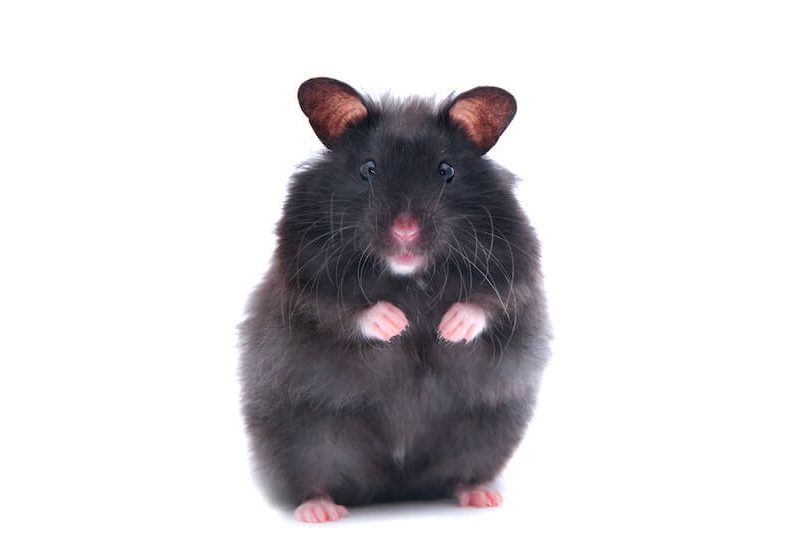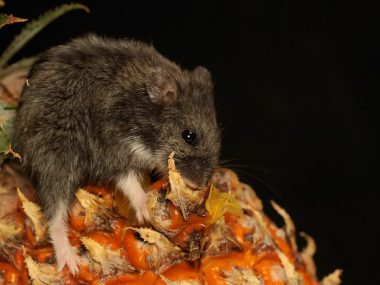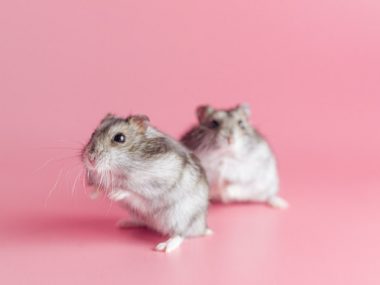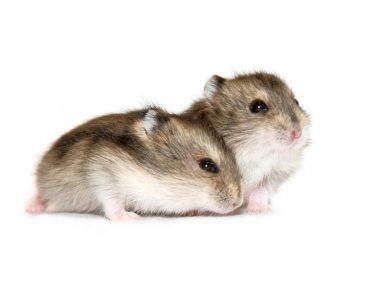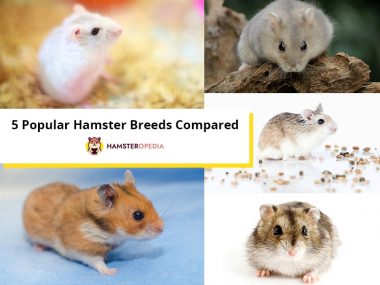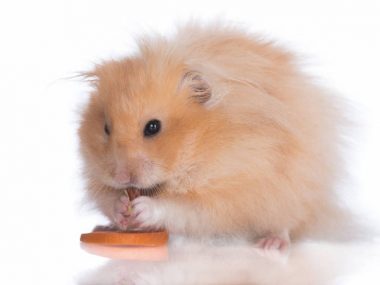If we told you that a little hamster has the features of a miniature black bear, would you believe us? Curious to find out? Keep reading to learn about the black bear hamster breed.
Table of Contents
What Is A Black Bear Hamster?
Many people ask, “What breed is a black bear hamster?” because they are oddly unique in appearance. You may be surprised to find out that a black bear hamster is a Syrian hamster (Mesocricetus auratus) with a black coat.
Are There Different Types Of Black Bear Hamsters?
Syrian hamsters are referred to by many names. These names are used to describe a Syrian hamster’s coat. It’s those descriptives that lead to the confusion of what exactly a black bear hamster is.
Syrian hamsters that are not black:
- Golden (short, tan-colored coat)
- Teddy Bear (long coat that can be various colors/patterns, and is straight or wavy)
- Fancy (has unique colorful coat features)
- Panda Bear (short, black and white-colored coat)
- Dalmatian (short, black and white spotted colored coat)
Syrian hamsters that are black:
- Black Bear (short, solid black coat coloring)
- European Black Bear Hamster (a black bear hamster of European origin)
- Black Teddy Bear Hamster (long coat that can have black varieties of colors/patterns and is straight or wavy)
Where Do Black Bear Hamsters Come From?
Syrian hamsters (which include black bear hamsters) are native to Syria (hence the name) and regions of the Middle East. A dense population of these hamsters thrives in the Aleppo Plateau of Syria, where the environment is arid and desert-like.
They tend to burrow deep, deep underground (up to 8 feet deep.) The depths of their burrows provide a cool and protected place to sleep during the day. Once the sun goes down, they pop up and out of their underground abode and go in search of food. Their nightly foraging ventures can consist of many miles traveled.
Black Bear Hamster Characteristics and Traits
Now we get down to the nitty-gritty stuff you’ve been waiting to read! Syrian hamsters (which include black bear hamsters) are one of the most diverse colored/patterned hamster species. If the colors and patterns don’t get you hooked, perhaps two eyes peeking out of long, curly hair will.
Black Bear Hamster At A Glance
- Coat: short or long
- Color: black or black with silver, or white
- Patterns: roan, banded, dominant spot, tortoiseshell
- Self or Agouti: self, agouti
- Eyes: black, black-red, black-blue, ruby, pink, heterochromatic
- Size: 6-8″, 4-5 oz.
- Lifespan: 18 months to 3 years
- Diet: omnivore
- Sexual maturation: 30 days
- Temperament: docile/sweet if handled as pups
- Level of care: moderate (not intended as a starter pet)
Black Bear Hamster Coat Characteristics
Black bear hamsters (Syrian) feature a black, black/white, or black/white/gray coat color. They have either short or long hair. Syrian hamsters are large, and the more hair they have, the more cuddly-looking they tend to be. Short-hair black bear hamsters have a plush, velvety, carpet-like appearance which is what draws attention.
Eyes, Ears, and Tail Characteristics
How would you like to have a plump, black plushy hamster with ruby red eyes that sparkle like gems? Or perhaps a pair of pink eyes that are strikingly against a black coat? But wait, we’re not done yet! Some of these hamsters may have one black eye and one red eye.
When it comes to their tail, there isn’t much to tell because there isn’t much of a tail! They have nubby-like tails that tend to disappear into the fur. Since we are featuring their back trunk area, it might help to mention they have two scent glands; one located on each hip area. The area where the glands are located may have less hair causing it to appear like a hairless spot.
Now we’ll move up towards their head where a pair of perky little ears sit listening to every noise. Some Syrian hamsters have ears that are lighter or darker than their coat; however, black bear hamsters are typically black on black with no color differentiation.
Black Bear Hamster Lifespan
Unlike cats or dogs, hamsters raised in the best conditions usually live 1-3 years, depending on their species. The life of a hamster can easily be cut short because of other pets or small children gaining access to one. Hamsters are notorious for jumping out of your hands (especially dwarf hamsters), and falling from heights can cause injury or death.
How Big Can A Black Bear Hamster Get?
Black bear hamsters grow up to about the size of a hotdog bun (6-8″.) Syrian hamsters (which includes black bear hamsters) are the largest of all hamster species. The smallest hamster is the Roborovski Dwarf, which only gets 1-2″ long (the size of a ping pong ball.)
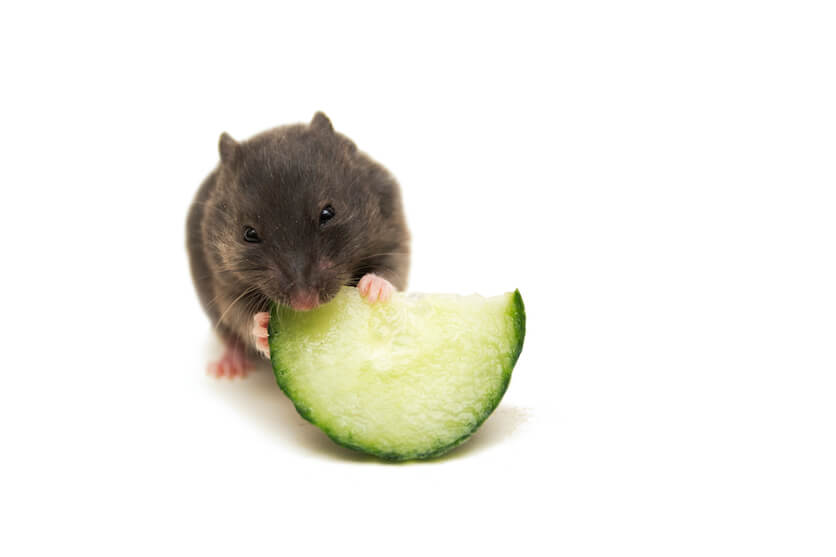
Black Bear Hamster Behavior
Of all the hamster species, you’ll find that Syrians (which includes black bear hamsters) are more docile. Dwarf hamsters are tiny balls of nerves all wrapped up like rubber bands just waiting to pop. They are easily stressed and hypervigilant, whereas Syrians are a lot more low-key.
Regardless of species, any hamster requires handling/taming to become acclimated and accustomed to its owner. Without this handling/taming, you’ll end up with a hamster that bites and doesn’t like human interaction. With patience and time, and diligent handling, a black bear hamster will become used to you, your voice, your touch, and your scent.
Do Black Bear Hamsters Like To Be Held?
There’s no such thing as a cuddly hamster fresh out of a pet store. For a hamster to get to a point where it is comfortable being held or touched, the owner must have committed to ample handling/taming. This process can take a week or several weeks to accomplish.
How Do You Tame A Black Bear Hamster?
Handling and taming are the same thing. Once you bring a new hamster home, you should expect it will be a while before it no longer tries to bite you, jump out of your hands, or hides in its cage.
Bringing Your Hamster Home
Day 1-3
- A new hamster should be placed in its cage upon arriving home. The cage should be in a quiet area yet near humans to become acclimated to voices and the presence of people.
- Avoid reaching into the cage except to clean, feed, or water.
- Prevent children from having access to the cage and the hamster.
- Keep pets away from the cage.
- The hamster will come to recognize your voice if you talk to it daily.
- Place a small item (sock, fabric, scarf, etc.) with your scent on it inside the cage.
Daily Handling/Taming
Day 3 (and daily thereafter). Handling sessions should be 10-15 minutes at the most. Also, since hamsters are nocturnal and sleep during the day, all handling should be done in the late evening.
- Handling should be done in a confined area on the floor. Things such as a child’s wading pool, large box, or pet pen with sides/flooring are ideal to do this in.
- Wash your hands before and after each handling session.
- Place the hamster’s cage near or in the confined handling area.
- As you approach the cage, softly talk to it.
- Reach into your hamster’s cage with a cupped hand to scoop it up. Be careful to prevent it from jumping out of your hands. It may bite, so if it does, cleanse the area with soap and water.
How To Care For A Black Bear Hamster
Caring for a hamster begins before you bring one home. It’s similar to preparing for the arrival of a baby. It would be best if you had everything set up and ready in advance.
Of course, you will want to show off your new pet, but hamsters are not fans of big crowds and can quickly become stressed. A fun way to let the world know that you are a proud new hamster parent is to wear a custom-made lapel pin featuring your very own tiny black bear! We found these custom pins that make great gifts for hamster owners.
Black Bear Hamster Cages
A black bear hamster (Syrian) should have a cage that is comfortable and a place to explore, exercise, and live.
Must-Have Accessories
- Nesting box
- Bedding (cedar and pine shavings should never be used)
- Wheel
- Water bottle
- Food bowl
- Toys
Cage Placement
A few specifics to know that helps in the placement of your hamster’s cage.
Avoid Placing Near or On:
- Exterior doors
- Windows
- Air vents
- Noisey items/places (stereo, tv, kid’s room, etc.)
- Unsturdy surfaces
The room temperature where the cage is placed should be 64-79 degrees (F.)
Black Bear Hamster Diet
Feeding your hamster a good quality pellet diet is best. Occasional treats are a welcome surprise. Check out our guide to feeding a hamster.
Toxic Foods To Avoid:
- Alcohol
- Caffeine (chocolate, tea, coffee, etc.)
- Citrus (oranges, lemons, limes, grapefruit, etc.)
- Nightshade vegetables (potatoes, tomatoes)
- Onions
- Garlic
Is It Better To Get A Male Or Female Black Syrian Hamster?
Male hamsters are more laid back compared to females. Females tend to be cranky and have territory issues when it comes to sharing their space. They are known for cannibalizing their own babies.
Although males have a better temperament than females, they are notorious for producing some odor when releasing a secretion from the scent glands. This secretion can be rather unpleasant, causing the cage and the hamster to become smelly.
Are Bear Hamsters Good Starter Pets?
Hamsters are not necessarily a good starter pet, especially for children. If you do decide to get one for a child, careful supervision is a must. Proper handling/taming is something both parent and child will need to do together. As for being a starter pet for adults, we suggest that you do your homework and know upfront what the responsibility is when it comes to caring for a hamster.
How Do You Know If A Black Bear Hamster Is Male Or Female?
The easiest way to tell the gender of a black bear hamster is to look at its underside. Females will have nipples (males don’t). If the hamster has two swollen (tumor-like) areas on each side of the anus, it’s a boy! The vagina of a female is closer to the anus, whereas the penis of the male is further away from the anus.
How Much Does A Black Bear Hamster Cost?
- Black bear syrian hamster: $12 – $30 (USD)
- Cage: $15 – $300 (USD)
- Accessories (wheel, nesting box, bedding:) $30 – $65 (USD)
- Food: $5 – $15 (USD)
This Hamster Might Be “Bear-y” Good
So, now that you know everything about a black bear hamster, is this the ultimate pet for your household needs? If you can check off yes to committing your time, be willing to handle/tame, expecting to be bitten, keeping it away from pets, and closely supervising children with a hamster, then a black bear hamster might fit the bill!
